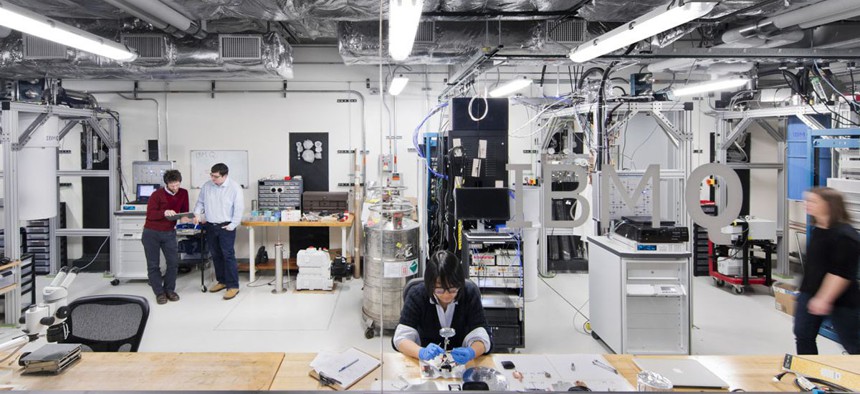IBM Thinks It’s Ready to Turn Quantum Computing Into an Actual Business

IBM's Q lab at its T.J. Watson research facility. Connie Zhou/IBM
IBM has announced it is forming IBM Q, a new division around its quantum computing research.
Today, IBM announced it is forming IBM Q, a new division around its quantum computing research. IBM has been working on quantum computing nearly as long as it’s been an area of study, but the new business unit is a bold indication it believes its research could be commercialized in the near future.
Last year, IBM introduced what it calls the “Quantum Experience,” a setup where researchers can carry out tests on one of IBM’s quantum computers, located at its T. J. Watson research lab in Yorktown Heights, New York, over the cloud. IBM said 40,000 users have run over 275,000 experiments on the computer, and it will likely be a source of use cases to show off to future clients.
The promise of quantum computing is that it could, in theory, lead to computers that are infinitely faster at processing information than even today’s fastest devices. Traditional computers comprise a series of transistors, electronic gates that can either be on or off (which are represented in programs as 1s and 0s). If transistors are made small enough, such as the size of a single atom, they start to exhibit the effects of quantum physics, and are referred to as “qubits.”
These transistors can both be 1 and 0 at the same time, what’s called the “superposition.” A computer made of qubits can, in essence, do all the steps of a calculation simultaneously, rather than in sequence like a traditional machine. It could therefore theoretically work far faster, solving problems that would require unattainable amounts of computing power today.
As it stands, IBM’s largest quantum computer has five qubits. By contrast the average laptop has hundreds of millions of bits in its processors, although the two types of computers are not directly comparable. IBM hopes, however, to continue its research with the aim of building quantum computers with roughly 50 qubits.
For comparison, an IBM spokesperson told Quartz, you can simulate the computational power of a 25-qubit quantum computer on a regular laptop. At about 45 qubits, you’d need the world’s fastest supercomputers, and above 50, “you couldn’t build large enough classical computing systems to simulate that size of a quantum system.”
In IBM’s vision of the future, quantum computers could be used for discovering new drugs, securing the internet, modeling the economy, or potentially even building far more powerful artificial intelligence systems—all sorts of exceedingly complicated tasks. One area the company is looking at right now is in chemistry, attempting to simulate what’s going on in a molecule.
“Even for simple molecules like caffeine, the number of quantum states in the molecule can be astoundingly large,” the spokesperson said, “so large that all the conventional computing memory and processing power scientists could ever build could not handle the problem.”
When Quartz visited IBM’s quantum computing lab in Yorktown Heights in 2015, the work being done was viewed as fundamental—research for the sake of research—rather than anything tied to specific business goals. But then again, so was the research that has since led to the creation of Watson. Originally conceived of to take on the question-as-answers gameshow of "Jeopardy!" which researchers saw as a “unique and compelling AI question,” Watson has become a set of machine-learning and AI services that IBM sells, and intends to invest $1 billion into.
As IBM’s core businesses of cloud services and data management have failed to kickstart growth—the company has experienced 19 consecutive quarters of falling revenue—it’s having to open itself up to different possibilities. Watson has yet to reverse IBM’s negative trend, although CEO Ginni Rometty recently said 1 billion people will interact with Watson in some capacity this year.
It remains to be seen whether quantum computing is ready for prime time. But if IBM is able to crack it, the results could be as important as any of the moonshots IBM has achieved over its 100-plus years of existence.





